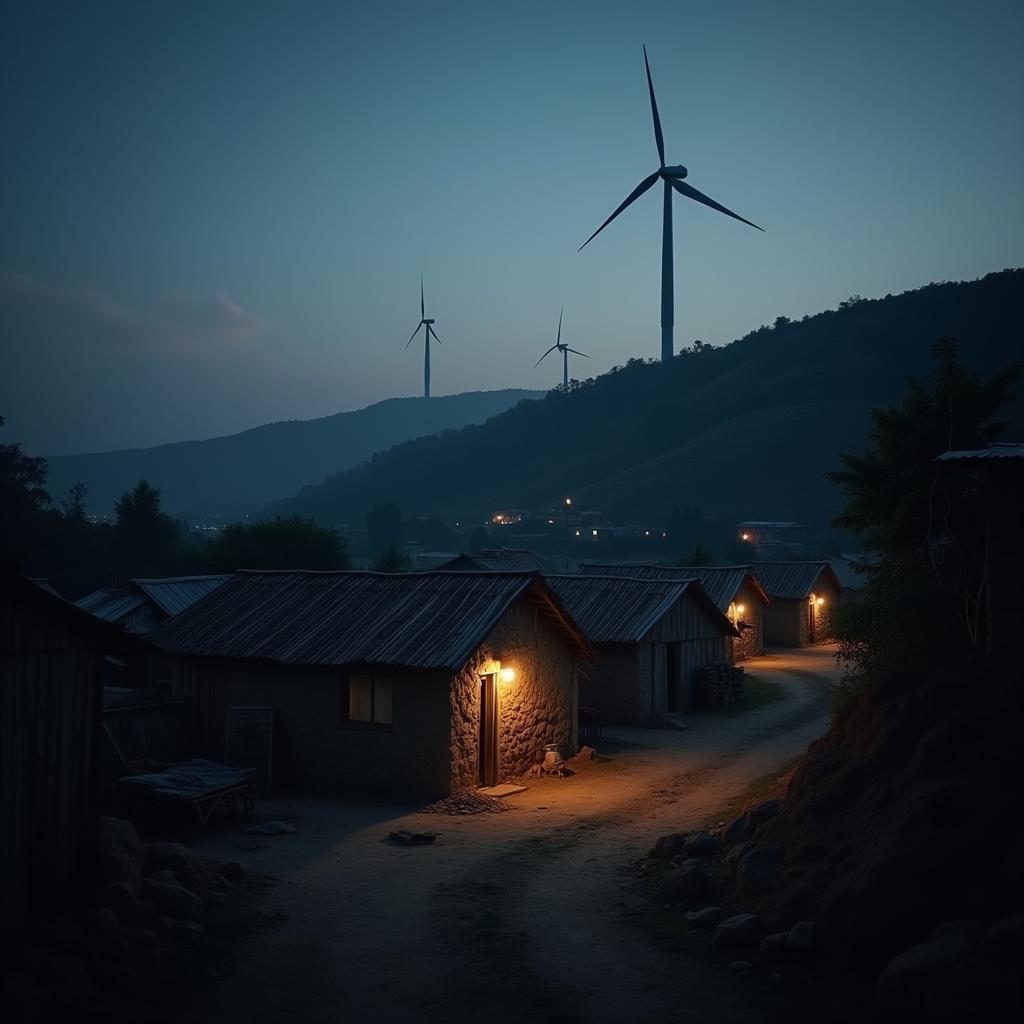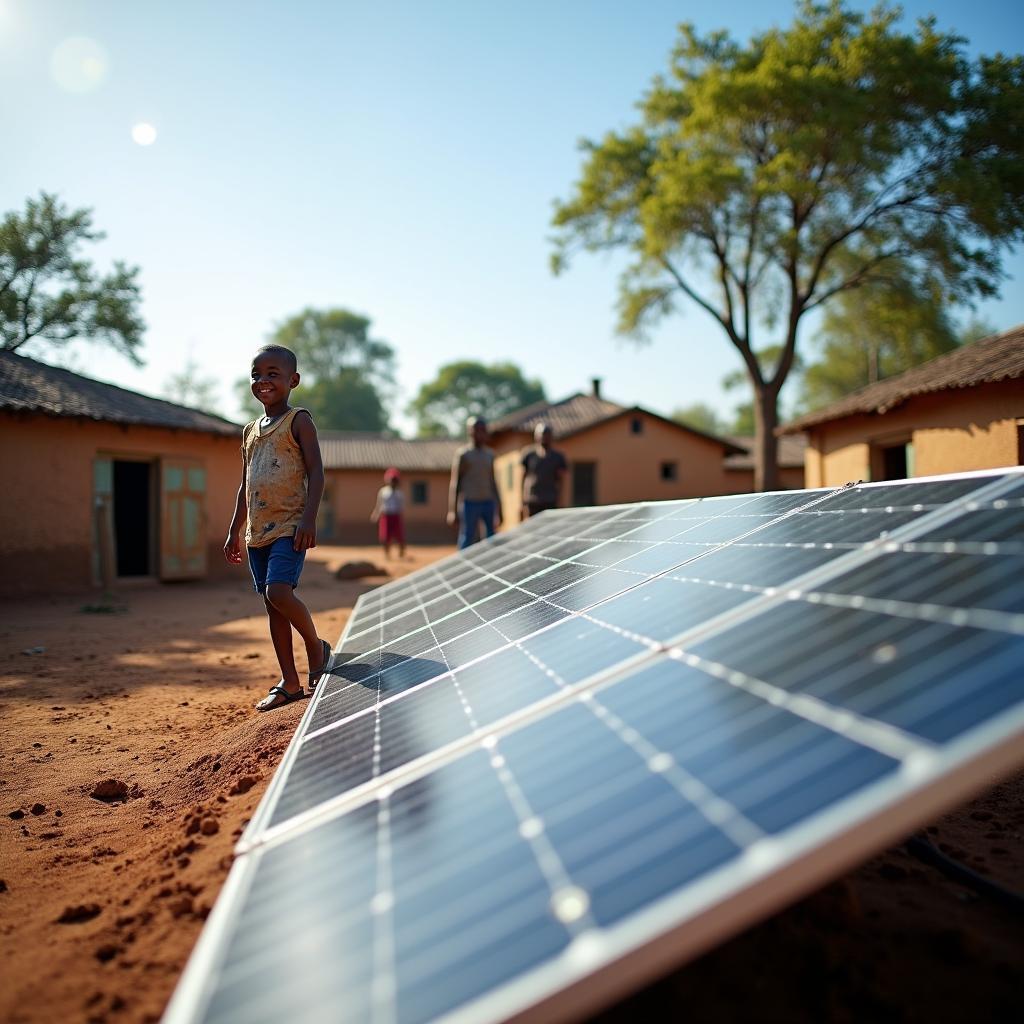Chủ đề năng lượng tái tạo luôn “nóng” trong IELTS Writing Task 2 bởi nó liên quan trực tiếp đến biến đổi khí hậu, công bằng năng lượng và phát triển bền vững. Cụm từ khóa “Challenges In Achieving Universal Renewable Energy Access” xuất hiện ngày càng nhiều trong đề thi thật và các nguồn luyện thi uy tín. Trong bài viết này, bạn sẽ nhận được: 3 bài mẫu hoàn chỉnh (Band 5-6, 6.5-7, 8-9), phân tích chấm điểm chi tiết theo 4 tiêu chí, chiến lược xử lý đề Problem–Solution/Opinion, danh sách từ vựng học thuật và 6 cấu trúc câu “ăn điểm”.
Nội dung bài viết
- 1. Đề Bài và Phân Tích
- 2. Bài mẫu Band 8-9
- Phân tích Band điểm
- Các yếu tố giúp bài này được chấm điểm cao
- 3. Bài mẫu Band 6.5-7
- Phân tích Band điểm
- So sánh với bài Band 8-9
- 4. Bài mẫu Band 5-6
- Phân tích Band điểm
- Những lỗi sai của bài – phân tích & giải thích
- Cách Cải Thiện Từ Band 6 Lên Band 7
- 5. Từ vựng quan trọng cần nhớ
- 6. Cấu trúc câu dễ ăn điểm cao
- 7. Checklist Tự Đánh Giá
- Kết bài
Một số đề thi thực tế đã được xác minh:
- Fossil fuels are the main source of energy; in some countries the use of alternative sources (such as wind and solar) is encouraged. To what extent is this a positive or negative development? (nguồn: IELTS Liz)
- Some people think governments should subsidise renewable energy to address environmental problems. To what extent do you agree or disagree? (nguồn: IELTS-Blog)
- Increasing the price of petrol is the best way to solve growing traffic and pollution problems. To what extent do you agree or disagree? (nguồn: British Council)
Trong phần sau, tôi chọn một đề gần với ý định tìm kiếm “challenges in achieving universal renewable energy access” để phân tích sâu, giúp bạn nắm cả ý tưởng lẫn kỹ thuật triển khai bài Band 7-9.
1. Đề Bài và Phân Tích
Despite significant progress, many countries still struggle to deliver universal access to renewable energy. What are the main challenges, and what measures could be taken to overcome them?
Dịch đề: Mặc dù đã có nhiều tiến bộ, nhiều quốc gia vẫn chật vật để cung cấp khả năng tiếp cận năng lượng tái tạo cho toàn dân. Những thách thức chính là gì và có thể áp dụng những biện pháp nào để vượt qua?
Phân tích đề bài:
- Dạng câu hỏi: Problem–Solution (nêu thách thức + đề xuất giải pháp). Bạn cần cân đối hai phần rõ ràng, tránh nghiêng hẳn về một bên.
- Thuật ngữ quan trọng:
- Universal access: khả năng tiếp cận cho toàn dân, không loại trừ vùng sâu vùng xa.
- Renewable energy: năng lượng tái tạo như gió, mặt trời, thủy điện nhỏ, sinh khối.
- Deliver/achieve access: không chỉ triển khai công nghệ mà còn đảm bảo tính sẵn có, ổn định, giá cả phải chăng.
- Lỗi thường gặp:
- Lệch đề sang “bảo vệ môi trường” chung chung, thiếu trọng tâm “access”.
- Đưa giải pháp mơ hồ, không khả thi (ví dụ: “chính phủ nên đầu tư nhiều hơn” mà không nêu cách, nguồn, cơ chế).
- Thiếu ví dụ/khía cạnh kỹ thuật chính: lưới điện, dự trữ năng lượng, vốn, khung pháp lý, năng lực kỹ thuật, chấp nhận xã hội.
- Cách tiếp cận chiến lược:
- Body 1: 2-3 thách thức cốt lõi (tài chính, hạ tầng lưới, gián đoạn/biến động nguồn, khung pháp lý).
- Body 2: 2-3 giải pháp khả thi (tài chính pha trộn, mini-grid/off-grid, thị trường điện minh bạch, đào tạo kỹ thuật).
- Kết luận: nhấn mạnh giải pháp phối hợp nhà nước–tư nhân–cộng đồng.
 Thách thức chính trong việc cung cấp năng lượng tái tạo toàn dân tại các vùng sâu vùng xa.
Thách thức chính trong việc cung cấp năng lượng tái tạo toàn dân tại các vùng sâu vùng xa.
2. Bài mẫu Band 8-9
Bài Band 8-9 cần: đáp ứng đầy đủ yêu cầu đề, lập luận logic, ví dụ thuyết phục, từ vựng học thuật chính xác và phạm vi ngữ pháp rộng, hạn chế lỗi.
Bài luận (khoảng 300 từ):
While renewable technologies have advanced rapidly, delivering universal access remains elusive because the obstacles are as much institutional and financial as they are technical. First, capital intensity is a formidable barrier: utility-scale solar and wind require large upfront investment, yet many governments face fiscal constraints and high borrowing costs. Second, weak grids undermine expansion. In numerous emerging economies, transmission lines are congested or non-existent, and intermittent renewables expose system operators to balancing and curtailment challenges. A third impediment is regulatory uncertainty: without bankable power-purchase agreements and predictable tariffs, private investors remain cautious.
To overcome these hurdles, a suite of complementary measures is essential. On finance, governments and development banks can deploy blended finance—combining concessional loans with private capital—to de-risk projects and lower the cost of capital. For access in remote regions, decentralised solutions such as solar mini-grids and pay-as-you-go systems can leapfrog weak national grids, provided consumer protection and after-sales service are ensured. Grid readiness must also improve: targeted investment in transmission, digital grid modernisation, and storage—particularly battery systems and pumped hydro—can smooth variability and reduce curtailment. Equally important is policy credibility. Transparent tenders, technology-neutral auctions, and time-bound feed-in premiums can create a competitive pipeline while avoiding over-subsidisation.
Finally, capacity building and social acceptance cannot be overlooked. Training local technicians, aligning vocational curricula with renewable operations, and engaging communities early through benefit-sharing schemes will minimise siting conflicts and improve long-term maintenance. In short, universal access to renewables will emerge not from a single silver bullet but from a coherent package that integrates finance, infrastructure, regulation, and human capital.
Phân tích Band điểm
| Tiêu chí | Band | Nhận xét |
|---|---|---|
| Task Response (Hoàn thành yêu cầu) | 8.5 | Trả lời đầy đủ hai phần “challenges + measures”, lập luận cân bằng và có tính khả thi. Quan điểm rõ ràng, ví dụ cụ thể, không lan man. |
| Coherence & Cohesion (Mạch lạc & Liên kết) | 8.0 | Bố cục mạch lạc: mở–thách thức–giải pháp–kết. Dụng ý chuyển đoạn logic, từ nối tự nhiên; tham chiếu ý mượt, không lạm dụng. |
| Lexical Resource (Từ vựng) | 8.5 | Từ vựng chuyên sâu: blended finance, curtailment, bankable PPAs, auctions. Collocations học thuật chính xác, hầu như không sai dùng từ. |
| Grammatical Range & Accuracy (Ngữ pháp) | 8.0 | Câu phức đa dạng (mệnh đề quan hệ, cụm phân từ, đảo ngữ nhẹ). Lỗi nhỏ nếu có không ảnh hưởng hiểu, dấu câu chính xác. |
Các yếu tố giúp bài này được chấm điểm cao
- Trọng tâm nhất quán vào “access”, không trôi sang môi trường chung chung.
- Nêu 3 thách thức cốt lõi: tài chính, lưới điện, khung pháp lý – có tính hệ thống.
- Giải pháp cụ thể và khả thi: blended finance, mini-grid, auctions, storage.
- Dùng thuật ngữ đúng ngữ cảnh: curtailment, bankable PPA, technology-neutral.
- Kết luận tổng hợp chiến lược tích hợp nhiều trụ cột, tránh “silver bullet”.
- Liên kết chặt chẽ giữa thách thức và giải pháp tương ứng.
- Văn phong học thuật nhưng tự nhiên, không “khoa trương”.
 Giải pháp lưới điện mini sử dụng năng lượng mặt trời giúp cung cấp điện cho các cộng đồng ở xa.
Giải pháp lưới điện mini sử dụng năng lượng mặt trời giúp cung cấp điện cho các cộng đồng ở xa.
3. Bài mẫu Band 6.5-7
Đặc điểm Band 6.5-7: trả lời đúng trọng tâm, có phát triển ý nhưng chưa thật sâu, ví dụ còn chung, từ vựng tương đối đa dạng song đôi chỗ lặp.
Bài luận (khoảng 260 từ):
Many countries want everyone to use clean energy, but achieving universal access is hard for several reasons. The first challenge is money: large solar or wind projects need big investment, and poorer governments cannot always afford low-interest loans. Another difficulty is the grid. In some places the grid is old or missing, so new renewable plants cannot connect easily, and when the sun or wind changes, the power supply becomes unstable. A third problem is policy. If rules about pricing or contracts change often, companies hesitate to invest.
There are realistic ways to improve this situation. Governments and international lenders could share risks to make loans cheaper, which would attract more private firms. For people in remote areas, small-scale solutions such as solar home systems or mini-grids can be installed faster than waiting for a national grid extension. Additionally, countries should modernise their grids and add energy storage to smooth fluctuations in production. Clear and transparent policies also matter: competitive auctions and fair tariffs can give investors confidence while protecting consumers.
Finally, skills and public support are important. Training local workers helps maintenance and creates jobs, and involving communities early can reduce resistance to new projects. In my view, a combination of finance, infrastructure and policy actions is the most practical way to expand access to renewables and make progress step by step.
Overall, coordinated efforts are essential to turn ambitious goals into reliable, affordable energy for all.
Phân tích Band điểm
| Tiêu chí | Band | Nhận xét |
|---|---|---|
| Task Response (Hoàn thành yêu cầu) | 7.0 | Trả lời đủ cả “challenges” và “measures”, có quan điểm. Ví dụ còn chung, độ sâu lập luận chưa tối ưu. |
| Coherence & Cohesion (Mạch lạc & Liên kết) | 7.0 | Cấu trúc rõ ràng; từ nối đơn giản nhưng hiệu quả. Một số câu chuyển ý còn cơ học. |
| Lexical Resource (Từ vựng) | 6.5 | Có thuật ngữ phù hợp (auctions, storage) nhưng lặp từ “problem/challenge”. Cần đa dạng hóa collocations. |
| Grammatical Range & Accuracy (Ngữ pháp) | 6.5 | Câu phức có dùng, lỗi nhỏ về mạo từ/giới từ đôi chỗ. Cấu trúc chưa thực sự đa dạng. |
So sánh với bài Band 8-9
- Ý tưởng: B8-9 cụ thể và có tính hệ thống; B6.5-7 nêu đúng nhưng ít chi tiết (ví dụ thiếu “blended finance”, “bankable PPAs”).
- Từ vựng: B8-9 dùng collocations chuyên ngành chính xác; B6.5-7 dùng từ phổ thông, lặp nhiều.
- Ngữ pháp: B8-9 đa dạng cấu trúc (cụm phân từ, câu chẻ); B6.5-7 chủ yếu câu đơn/câu ghép.
- Mạch lạc: B8-9 liên kết ý theo cặp “thách thức–giải pháp”; B6.5-7 trình bày tuần tự, ít móc nối.
4. Bài mẫu Band 5-6
Đặc điểm Band 5-6: bám đề nhưng phát triển ý còn nông, ví dụ yếu, lỗi ngữ pháp và từ vựng rõ, liên kết chưa chặt.
Bài luận (khoảng 255 từ) – có làm nổi bật lỗi sai:
Many governments want universal renewable energy, but there are many problems. First, it is very expensive, so countries cannot invest enough and the projects are delay. Second, the grid is not good and sometimes it collapse when renewables come. In rural areas, people live far and the company don’t want to build lines because it is not profit. Also, the policy are changing and investors feel uncertainly.
To solve, the government should spend more money and make subsidy for everybody. They can buy batteries which can keep energy for night, and they must fix the grid and make it more strong. In villages, solar panels can be used for each house, and people can pay by slowly. If the rules are clear, companies will invest and they will build more projects fastly. Also, teach people to use and repair the new system is needed.
In conclusion, there are many challenges but we should do it quickly because climate change is serious and we cannot wait. If government and companies work together, renewable energy access will be success.
Phân tích Band điểm
| Tiêu chí | Band | Nhận xét |
|---|---|---|
| Task Response (Hoàn thành yêu cầu) | 5.5 | Có nêu thách thức và giải pháp nhưng chung chung, thiếu chi tiết và ví dụ. Kết luận đơn giản. |
| Coherence & Cohesion (Mạch lạc & Liên kết) | 5.5 | Chia đoạn rõ nhưng liên kết yếu, lặp ý, chuyển đoạn đột ngột. |
| Lexical Resource (Từ vựng) | 5.5 | Từ vựng cơ bản, dùng sai từ loại (uncertainly), collocation chưa tự nhiên. |
| Grammatical Range & Accuracy (Ngữ pháp) | 5.0 | Nhiều lỗi thì, chủ-vị, danh–động từ, trạng từ–tính từ. Cấu trúc câu đơn giản. |
Những lỗi sai của bài – phân tích & giải thích
| Lỗi sai | Loại lỗi | Sửa lại | Giải thích |
|---|---|---|---|
| delay | Từ loại | delayed | Cần tính từ/động từ phân từ sau “are”; “projects are delayed”. |
| collapse | Chủ–vị/động từ | collapses | Chủ ngữ “the grid” số ít ⇒ động từ ngôi 3 số ít. |
| don’t | Chủ–vị | doesn’t | “the company” số ít ⇒ doesn’t. |
| are changing | Thì/ý nghĩa | change frequently | Diễn đạt chính sách hay thay đổi; dùng trạng từ “frequently” tự nhiên hơn. |
| uncertainly | Từ loại | uncertain | Cần tính từ sau “feel”: “feel uncertain”. |
| subsidy | Danh từ số ít/đếm được | subsidies | “make subsidies” hoặc “provide subsidies” số nhiều phù hợp ngữ cảnh. |
| by slowly | Giới từ/trạng từ | slowly/in instalments | “Pay slowly” hoặc “pay in instalments” đúng collocation. |
| fastly | Trạng từ bất quy tắc | fast/quickly | “fast” hoặc “quickly” là trạng từ đúng. |
| teach people to use and repair the new system is needed | Cấu trúc | Training people to use and maintain the new systems is needed | Dùng danh động từ làm chủ ngữ; “maintain” phù hợp kỹ thuật. |
| will be success | Danh từ vs tính từ | will be successful | “Successful” là tính từ; “success” là danh từ. |
Cách Cải Thiện Từ Band 6 Lên Band 7
- Thêm chi tiết kỹ thuật khả thi: mini-grids, storage, auctions, concessional loans.
- Nâng collocations: grid stability, capital costs, investor confidence, policy certainty.
- Đa dạng cấu trúc: mệnh đề quan hệ, cụm phân từ, câu chẻ để nhấn ý.
- Sửa lỗi ngữ pháp cơ bản: chủ–vị, mạo từ, trạng từ–tính từ, tiền tố–hậu tố.
- Minh họa bằng một ví dụ cụ thể (ví dụ mô hình trả góp pay-as-you-go ở nông thôn).
- Dùng từ nối logic hơn: consequently, in parallel, to that end, by contrast.
5. Từ vựng quan trọng cần nhớ
| Từ/Cụm từ | Loại từ | Phiên âm | Nghĩa tiếng Việt | Ví dụ (English) | Collocations |
|---|---|---|---|---|---|
| universal access | n. | /ˌjuːnɪˈvɜːrsl ˈækses/ | tiếp cận toàn dân | Universal access to clean power remains a policy goal. | ensure/expand/achieve universal access |
| capital intensity | n. | /ˈkæpɪtl ɪnˈtensəti/ | cường độ vốn cao | The capital intensity of offshore wind is significant. | high/low capital intensity |
| concessional loan | n. | /kənˈseʃənl loʊn/ | khoản vay ưu đãi | Concessional loans can de-risk early projects. | provide/secure concessional loans |
| blended finance | n. | /ˈblendɪd fəˈnæns/ | tài chính pha trộn | Blended finance attracts private investors. | blended-finance vehicle/scheme |
| bankable PPA | n. | /ˈbæŋkəbəl ˌpiː piː ˈeɪ/ | hợp đồng mua bán điện “đủ điều kiện vay” | Investors require a bankable PPA. | sign/secure a bankable PPA |
| curtailment | n. | /kɜːrˈteɪlmənt/ | cắt giảm phát điện | Storage can reduce solar curtailment. | reduce/avoid curtailment |
| mini-grid | n. | /ˈmɪni ɡrɪd/ | lưới điện mini | Mini-grids can serve remote villages. | deploy/operate mini-grids |
| pay-as-you-go | adj. | /ˌpeɪ əz juː ˈɡoʊ/ | trả theo mức dùng/trả dần | Pay-as-you-go solar is affordable. | pay-as-you-go model/plan |
| grid modernisation | n. | /ɡrɪd ˌmɒdərnɪˈzeɪʃn/ | hiện đại hóa lưới | Grid modernisation enables renewables. | invest in grid modernisation |
| technology-neutral auction | n. | /tekˈnɒlədʒi ˈnuːtrəl ˈɔːkʃn/ | đấu thầu trung lập công nghệ | A technology-neutral auction lowers costs. | run/launch/award auctions |
| policy certainty | n. | /ˈpɒlɪsi ˈsɜːtnti/ | tính ổn định chính sách | Policy certainty builds investor confidence. | provide/enhance policy certainty |
| investor confidence | n. | /ɪnˈvɛstər ˈkɒnfɪdəns/ | niềm tin nhà đầu tư | Transparent rules boost investor confidence. | build/restore investor confidence |
| leapfrog | v. | /ˈliːpfrɒɡ/ | vượt bậc, nhảy cóc | Off-grid solutions can leapfrog weak grids. | leapfrog constraints/barriers |
| benefit-sharing | n. | /ˈbɛnɪfɪt ˌʃeərɪŋ/ | chia sẻ lợi ích | Benefit-sharing increases social acceptance. | design/implement benefit-sharing |
| social acceptance | n. | /ˈsoʊʃl əkˈseptəns/ | chấp nhận xã hội | Early engagement improves social acceptance. | gain/improve social acceptance |
Lưu ý phát âm: luyện /ə/ và /ɜː/ với “concessional”, “curtailment”; nhấn trọng âm đúng để tránh “nuốt âm”.
 Đào tạo kỹ thuật viên địa phương lắp đặt và bảo trì hệ thống năng lượng tái tạo như tấm pin mặt trời.
Đào tạo kỹ thuật viên địa phương lắp đặt và bảo trì hệ thống năng lượng tái tạo như tấm pin mặt trời.
6. Cấu trúc câu dễ ăn điểm cao
Câu phức với mệnh đề phụ thuộc
- Công thức: Mệnh đề chính + because/although/while + mệnh đề phụ.
- Ví dụ từ bài Band 8-9: While renewable technologies have advanced rapidly, delivering universal access remains elusive.
- Vì sao ghi điểm: Tạo tương phản lập luận rõ ràng, thể hiện khả năng xử lý ý phức.
- Ví dụ bổ sung: Although costs are falling, financing remains a bottleneck. Because grids are weak, curtailment rises.
- Lỗi thường gặp: Dùng dấu phẩy sai hoặc thiếu mệnh đề chính.
Mệnh đề quan hệ không xác định
- Công thức: Mệnh đề, which + V, mệnh đề.
- Ví dụ: …transmission lines are congested or non-existent, which exposes operators to curtailment challenges.
- Ghi điểm: Bổ sung thông tin mượt, tăng tính học thuật.
- Ví dụ: Auctions were delayed, which discouraged investors. The policy shifted, which raised uncertainty.
- Lỗi: Nhầm which/that; quên dấu phẩy.
Cụm phân từ (participial phrases)
- Công thức: V-ing/V-ed + cụm, mệnh đề.
- Ví dụ: Training local technicians, aligning vocational curricula… will minimise conflicts.
- Ghi điểm: Nén thông tin, nhịp văn tự nhiên.
- Ví dụ: Facing high capital costs, many firms delay projects. Designed poorly, subsidies distort markets.
- Lỗi: Treo chủ ngữ (dangling participle).
Câu chẻ (Cleft sentences)
- Công thức: It is/was + X + that/who + mệnh đề.
- Ví dụ: It is policy credibility that creates a competitive pipeline.
- Ghi điểm: Nhấn mạnh trọng tâm.
- Ví dụ: It is grid readiness that determines reliability. It was blended finance that unlocked private capital.
- Lỗi: Lạm dụng gây nặng nề.
Câu điều kiện nâng cao
- Công thức: If + S + were to V / should + V, S + would/could + V.
- Ví dụ: If governments were to deploy blended finance, costs would fall substantially.
- Ghi điểm: Nêu giả định chính sách linh hoạt.
- Ví dụ: Should tariffs remain unstable, investors would retreat. If storage were widespread, curtailment would drop.
- Lỗi: Sai thì hoặc thiếu đảo ngữ với “should”.
Đảo ngữ
- Công thức: Not until/Only when/Under no circumstances + trợ động từ + S + V.
- Ví dụ: Only when regulation is predictable can universal access accelerate.
- Ghi điểm: Tạo nhấn mạnh học thuật, đa dạng hóa cú pháp.
- Ví dụ: Not until grids are modernised will stability improve. Under no circumstances should safety be compromised.
- Lỗi: Quên đảo trợ động từ.
7. Checklist Tự Đánh Giá
- Trước khi viết:
- Xác định dạng bài: Problem–Solution hay Opinion?
- Khoanh vùng ý: finance, grid, regulation, skills, social acceptance.
- Lập dàn ý 2 thân bài song song thách thức–giải pháp.
- Trong khi viết:
- Mỗi đoạn 1 ý chính + 2 hỗ trợ + ví dụ.
- Dùng từ nối logic: consequently, to that end, in parallel.
- Kiểm tra mạo từ, chủ–vị, thì.
- Sau khi viết:
- Soát collocations: investor confidence, grid stability, capital costs.
- Cắt lặp từ; thay thế bằng từ đồng nghĩa phù hợp.
- Kiểm tra số từ: 270–320 cho an toàn.
- Mẹo quản lý thời gian:
- 5 phút lên dàn ý, 25 phút viết, 5 phút soát lỗi.
- Viết câu chủ đề trước, ví dụ sau.
- Ưu tiên rõ ràng hơn hoa mỹ.
Kết bài
Bạn vừa đi qua một lộ trình hoàn chỉnh để chinh phục đề “challenges in achieving universal renewable energy access” trong IELTS Writing Task 2: hiểu đúng trọng tâm “access”, hệ thống hóa thách thức–giải pháp, nắm từ vựng học thuật, và vận dụng 6 cấu trúc câu “ăn điểm”. Con đường cải thiện khả thi: mỗi tuần luyện 2 bài theo dàn ý trong bài, sau 4–6 tuần bạn sẽ thấy mạch lạc hơn, ít lỗi và từ vựng tự nhiên hơn. Hãy luyện viết một bài theo đề trong mục 1, đăng trong phần bình luận để nhận phản hồi từ cộng đồng học viên [internal_link: chủ đề]. Đừng quên áp dụng checklist khi soát lỗi lần cuối.
Để tiến bộ bền vững, bạn có thể tham khảo thêm các nguồn chính thống như IELTS Liz, British Council và IELTS-Blog cho đề bài và ý tưởng gần với đề thi. Nhớ rằng, điểm số đến từ sự ổn định: tư duy rõ, dàn ý chặt, ngôn từ chính xác và ví dụ khả thi. Bắt đầu ngay hôm nay, bạn sẽ “mở khóa” bài Task 2 về năng lượng tái tạo một cách tự tin và hiệu quả.


